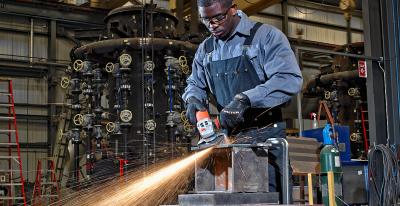
Walter Surface Technologies introduces the Xcavator with Comfort Max Technology - a grinding wheel that reduces grinding time while increasing operator comfort and overall plant productivity in industrial metalworking applications.
The Xcavator integrates the latest advancements in Type 27 depressed-center grinding wheels. By incorporating Comfort Max Technology at the hub of the wheel, it helps minimize vibration, and provides operators with more comfortable, ergonomic working conditions, without sacrificing performance and safety.
“Grinding is one of the toughest, most demanding tasks in the metalworking industry because of the excessive noise, dust, and vibration,” explained Marc Brunet-Gagné, product manager of bonded abrasives at Walter Surface Technologies. “With Comfort Max Technology the new Xcavator reduces operating vibrations by up to 15 percent when compared to its predecessor. This allows for a smoother, more comfortable grinding experience, which helps to reduce fatigue and vibration-induced pain in the hands and arms of the operator - all without sacrificing performance.”
Tested on some of the world’s hardest metals – including tungsten carbide and tempered steel, the Xcavator with Comfort Max Technology helps ensure optimal power transfer from operator to working surface. It also features Walter’s patented UHR (ultra-high removal) multi-layer manufacturing technology to prevent edge flaking – keeping the wheel symmetrically round for added safety and longer life.
Ideal for use on steel and stainless steel, Xcavator with Comfort Max Technology is free of materials such as iron, sulfur and chlorine.
Contact Details
Related Glossary Terms
- fatigue
fatigue
Phenomenon leading to fracture under repeated or fluctuating stresses having a maximum value less than the tensile strength of the material. Fatigue fractures are progressive, beginning as minute cracks that grow under the action of the fluctuating stress.
- grinding
grinding
Machining operation in which material is removed from the workpiece by a powered abrasive wheel, stone, belt, paste, sheet, compound, slurry, etc. Takes various forms: surface grinding (creates flat and/or squared surfaces); cylindrical grinding (for external cylindrical and tapered shapes, fillets, undercuts, etc.); centerless grinding; chamfering; thread and form grinding; tool and cutter grinding; offhand grinding; lapping and polishing (grinding with extremely fine grits to create ultrasmooth surfaces); honing; and disc grinding.
- grinding wheel
grinding wheel
Wheel formed from abrasive material mixed in a suitable matrix. Takes a variety of shapes but falls into two basic categories: one that cuts on its periphery, as in reciprocating grinding, and one that cuts on its side or face, as in tool and cutter grinding.
- metalworking
metalworking
Any manufacturing process in which metal is processed or machined such that the workpiece is given a new shape. Broadly defined, the term includes processes such as design and layout, heat-treating, material handling and inspection.
- tungsten carbide ( WC)
tungsten carbide ( WC)
Intermetallic compound consisting of equal parts, by atomic weight, of tungsten and carbon. Sometimes tungsten carbide is used in reference to the cemented tungsten carbide material with cobalt added and/or with titanium carbide or tantalum carbide added. Thus, the tungsten carbide may be used to refer to pure tungsten carbide as well as co-bonded tungsten carbide, which may or may not contain added titanium carbide and/or tantalum carbide.
